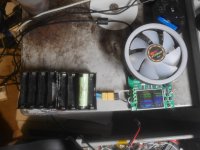Found the Atorch DL24 with bluetooth on the Ali website. Approximately how long does it take to discharge at say 3A?
3A discharge rate with 400 cells from 4.2V to 3.65V will take forever. If you decide to buy get the DL24P discharging at 15-20amps rate with no more than 150W drain. It's the
ATorch DL24P (180W rating) shown in above photo, but best not to discharge above 150W for extending usable life as long as possible.
Here's one example with
six used (good condition)
18650 30Q cells connected in parallel. They were at 4.11V. Then discharged at 15amp rate for 45 minutes with bounce back resting voltage at approximately 3.70V. Figured cell capacity of 2700mAh x 6 = 16.2Ah capacity.
Wattage draw as high as 58W at beginning and 46W at end of 45 minutes. 150W divided by 50W drain = 3 x 6 cells equals 18 cells in parallel figuring 150W drain. So, 400 cells
÷ 18 = 22.2 times. So, 23 x 45 minutes = 1035 minutes to discharge 400 18650 cells (2700mAh) from say 4.20V to 3.80V (bounce back resting voltage after 2 hours).
That's a rough estmiate of discharge time if actual mAh capacity of each cell is about 2700mAh. If only storing for a few months then 3.80V or even 3.85V is ok. Best to at least balance all 400 within 100 mV (0.10V) of each other before discharging to storage voltage. You can always balance them later within 25 to 30mV before fabricating your battery pack.
Another quicker way with 30 cells at a time (6s5p) using a Vruzend V.2 kit. Then with two used 12V headlights (connected in series) discharging to desired resting storage voltage. Nice if you could use a Watt Meter inline to track discharge wattage, voltage, amps. There may be an ES member that would give you his V.2 kit that he no longer uses (just pay shipping/handling). Don't use the older V.1 kit (even if free) as it doesn't come with shoulder bolts so end caps aren't always compressed against cell ends for good contact.
Hope this isn't confusing, but maybe helpful.


